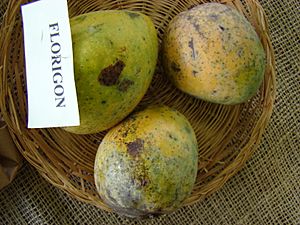Florigon facts for kids
Quick facts for kids Mangifera 'Florigon' |
|
|---|---|

Display of Florigon mango at the Redland Summer Fruit Festival, Fruit and Spice Park, Homestead, Florida
|
|
| Genus | Mangifera |
| Species | Mangifera indica |
| Cultivar | 'Florigon' |
| Origin | Florida, USA |
The Florigon mango is a special type of mango that first grew in south Florida, United States. It is known for its delicious taste and is now a popular choice for mango lovers.
The Story of Florigon Mango
This unique mango started from a seed planted in 1932. It was planted by John G. Kaiser in Fort Lauderdale, Florida. Mr. Kaiser was known for growing new kinds of mangos.
People first thought the 'Florigon' came from a 'Saigon' mango. But later studies suggest its parent might have been the 'Haden' mango. The name 'Florigon' mixes 'Florida' and 'Saigon'. The tree first grew fruit in 1936.
At first, not many people noticed the 'Florigon' mango. But now, it's loved for its amazing taste. It's also good at growing lots of fruit and resisting diseases. You can buy 'Florigon' trees in Florida. It's even grown a little bit for sale.
You can find 'Florigon' trees at the University of Florida's Tropical Research and Education Center. They are also at the Miami-Dade Fruit and Spice Park. Both places are in Homestead, Florida. The very first 'Florigon' tree is still growing in Fort Lauderdale!
What Does a Florigon Mango Look Like?
The 'Florigon' fruit is small and oval-shaped. It usually weighs less than one pound. When it's ripe, it's almost completely yellow. Sometimes it has a light pink blush.
The inside of the mango is yellow and very sweet. It has a mild flavor and no stringy fibers. The seed inside can grow more than one plant. 'Florigon' mangos are ready to eat from May to July in Florida.
The 'Florigon' mango trees grow to a medium size. They have branches that grow upwards and are not too dense.

